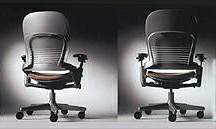| Steelcase
International Asia-Pacific |
 
|
|

. |
|
 |
Steelcase introduces new
seating technology.
Steelcase launches first-of-a-kind office chair designed to
mimic the movements of the spine and address the
occurrence of back pain in the workplace
� Four
years of research indicate that the body and spine
move in ways that today's chairs don't support |
� Technology
provides a healthier way to sit by supporting the independent
motions of the upper and lower back
� Company to
license the technology
|
|
Upper
and Lower Back Move in Distinct Directions
Based on the findings of physical
therapists, biomechanical engineers and ergonomic experts, Steelcase developed the
revolutionary Leap chair. Leap is the first chair to conform to each individual's unique
spinal motion -- his or her "spineprint" and provides independent controls for
the upper and lower back, which move in different directions when a user changes
positions.
|
Breakthrough
Findings/Breakthrough Features
The lengthy research effort resulted in four
major findings about the back, neck, arms and other parts of the body when a person is seated:
• The
Finding:
The spine does not move as a single unit, preferring to move in
ways not allowed by most chairs today. When reclining, the upper back wants to move backward and
the lower back wants to move forward. Today's chairs with rigid backrests can't
follow this
motion, creating a "gap" in the lower back area - as your lower back wants to move
forward, but the chair's lower back can't. Users may then let their lower back
sag, moving themselves into a hunched posture that is hard on the back.
A Live BackTM that changes shape to mimic the ways the spine changes shape.
• The Finding: Each
individual's spinal motion is unique. Just as fingerprints are unique, so are
"spineprints," meaning that the upper and lower back each comprise discrete joints - 12
in the upper, five in the lower - that act independently of one another. When a person sits, he or
she moves instinctively in ways that best support the spine at a particular moment, changing
positions from time to time to accommodate the spine's changing needs.The Live Back literally adapts to each person's one-of-a-kind
spine as it changes shape throughout the day.
• The
Finding: The upper and lower back regions require different kinds and
amounts of support. Researchers discovered that, no matter how a person sits, the lower back
requires a small, but constant amount of support to maintain the natural curve of the lower spine.
The amount of support needed for the upper back is greater and increases as an individual
reclines. Separate upper and lower back
controls to accommodate the different amounts of support that the upper and lower spine requires.
• The Finding:
Vision
and reach affect posture. The "vision and reach zone" is where people position
themselves at their desks to see and work comfortably in relation to their computer monitors,
keyboards, telephones, etc. Nearly all office chairs on the market today are built off tilt
mechanisms, which when you recline, move you out of this zone and away from your work. Users
compensate by squinting, stretching or going back to an upright posture, putting more stress on
discs and sitting bones.The Natural Glide SystemTM. As users recline, the
seat glides forward. This motion allows the user to recline without leaving their "vision and
reach zone" or making unhealthy compromises. By reclining, users put less pressure on the
sitting bones and discs, yet they remain oriented to their work, which puts less stress on the
eyes, arms and wrists.
|
|
l
index
l press release
l chair
background l seating
guide l testimonials
l.where
|
|
|
|
|
|
 Back to Home Back to Home
|
n e t w o r k |
our network partners |
designasia.com
productsasia.com
ICN |
|
|